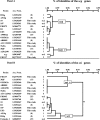Biotyping of enterotoxigenic Staphylococcus aureus by enterotoxin gene cluster (egc) polymorphism and spa typing analyses
- PMID: 16957237
- PMCID: PMC1563601
- DOI: 10.1128/AEM.00773-06
Biotyping of enterotoxigenic Staphylococcus aureus by enterotoxin gene cluster (egc) polymorphism and spa typing analyses
Abstract
Thirty-five Staphylococcus aureus strains, including 10 reference strains and 25 strains recovered from clinical specimens and food samples, were analyzed by PCR REA (restriction endonucleases analysis) of the egc operon and spa typing. Nineteen spa types and seven different egc operons, including four putative new egc variants, were revealed. In 13 strains, allelic variants of sei and/or seg were found. By an analysis of their nucleotide sequence identities, a new homogeneous cluster of a sei variant, called the sei variant, was detected in six strains. In addition, the prototype sei was shown to be more polymorphic than assumed so far. Seven strains possessed the recently described seg variant, also exhibiting several nucleotide exchanges. spa typing was more effective than REA egc grouping as a typing technique. Since, in some cases, the REA typing method was able to discriminate strains showing the same spa type, it must be considered for PCR approaches involved in diagnostic procedures and may be useful for epidemiological studies. Hence, the polyphasic approach used in this study can be reliably and advantageously applied for typing egc-positive S. aureus strains.
Figures


References
-
- Abe, J., Y. Ito, M. Onimaru, T. Kohsaka, and T. Takeda. 2000. Characterization and distribution of a new enterotoxin-related superantigen produced by Staphylococcus aureus. Microbiol. Immunol. 44:79-88. - PubMed
-
- Baba, T., F. Takeuchi, M. Kuroda, H. Yuzawa, K. Aoki, A. Oguchi, Y. Nagai, N. Iwama, K. Asano, T. Naimi, H. Kuroda, L. Cui, K. Yamamoto, and K. Hiramatsu. 2002. Genome and virulence determinants of high virulence community-acquired MRSA. Lancet 359:1819-1827. - PubMed
-
- Becker, K., A. W. Friedrich, G. Peters, and C. von Eiff. 2004. Systematic survey on the prevalence of genes coding for staphylococcal enterotoxins SElM, SElO, and SElN. Mol. Nutr. Food Res. 48:488-495. - PubMed
Publication types
MeSH terms
Substances
Associated data
- Actions
- Actions
- Actions
- Actions
- Actions
- Actions
- Actions
- Actions
- Actions
- Actions
- Actions
- Actions
- Actions
- Actions
- Actions
- Actions
LinkOut - more resources
Full Text Sources
Molecular Biology Databases

